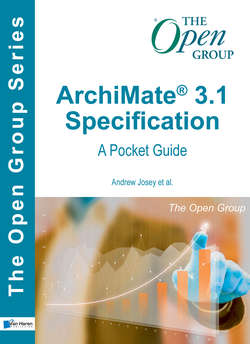Читать книгу ArchiMate® 3.1 - A Pocket Guide - The Open Group - Страница 12
На сайте Литреса книга снята с продажи.
ОглавлениеChapter 2
Language Structure
This chapter describes the construction of the ArchiMate language.
Topics addressed in this chapter include:
• The top-level language structure
• Layering
• The ArchiMate Framework
2.1 Top-Level Language Structure
Figure 2 outlines the top-level hierarchical structure of the language:
• A model is a collection of concepts. A concept is an element, a relationship, or a relationship connector
• An element is a behavior element, a structure element, a motivation element, or a composite element
Figure 2: Top-Level Hierarchy of ArchiMate Concepts
| Figure 2 describes abstract concepts; they are not intended to be used directly in models. To signify this, they are depicted in white with labels in italics. |
2.2 Layering of the ArchiMate Language
The ArchiMate core language defines a structure of generic elements and their relationships, which can be specialized in different layers. Three layers are defined within the ArchiMate core language as follows:
1. The Business Layer depicts business services offered to customers, which are realized in the organization by business processes performed by business actors.
2. The Application Layer depicts application services that support the business, and the applications that realize them.
3. The Technology Layer depicts technology services such as processing, storage, and communication services needed to run the applications, and the computer and communication hardware and system software that realize those services. Physical elements are included for modeling physical equipment, materials, and distribution networks to this layer.
The general structure of models within the different layers is similar. The same types of elements and relationships are used, although their exact nature and granularity differ.
In alignment with service-orientation, the most important relationship between layers is formed by “serving” relationships, which show how the elements in one layer are served by the services of other layers. (Note, however, that services need not only serve elements in another layer, but also can serve elements in the same layer.) A second type of link is formed by realization relationships: elements in lower layers may realize comparable elements in higher layers; e.g., a “data object” (Application Layer) may realize a “business object” (Business Layer); or an “artifact” (Technology Layer) may realize either a “data object” or an “application component” (Application Layer).
